Note
Go to the end to download the full example code.
Earth Albedo BRDF#
Modeling the incident radiation at a spacecraft due to reflected sunlight from the Earth
Useful papers not cited below: Kuvyrkin 2016 Strahler 1999
Let’s first load the coefficient arrays \(f_{iso}\), \(f_{geo}\), and \(f_{vol}\) from file
import matplotlib as mpl
import matplotlib.pyplot as plt
import numpy as np
import mirage as mr
import mirage.vis as mrv
save_dict = mr.load_albedo_file()
fiso_map = np.array(save_dict['fiso_map'])
fgeo_map = np.array(save_dict['fgeo_map'])
fvol_map = np.array(save_dict['fvol_map'])
lat_geod_grid = np.array(save_dict['lat_geod_grid'])
lon_grid = np.array(save_dict['lon_grid'])
lat_geod_space = lat_geod_grid[:, 0]
lon_space = lon_grid[0, :]
mapshape = lon_grid.shape
The surface BRDF function in Blanc 2014
pws = (
lambda ts, fiso, fgeo, fvol: fiso
+ fvol * (-0.007574 - 0.070987 * ts**2 + 0.307588 * ts**3)
+ fgeo * (-1.284909 - 0.166314 * ts**2 + 0.041840 * ts**3)
)
pbs = lambda ts, fiso, fgeo, fvol: fiso + 0.189184 * fvol - 1.377622 * fgeo
albedo = lambda ts, fiso, fgeo, fvol: 0.5 * pws(ts, fiso, fgeo, fvol) + 0.5 * pbs(
ts, fiso, fgeo, fvol
)
Now we define the date to evaluate the reflected albedo irradiance at and the ECEF position of the satellite
date = mr.utc(2022, 6, 23, 5, 53, 0)
datestr = f'{date.strftime("%Y-%m-%d %H:%M:%S")} UTC'
sat_pos_ecef = (mr.AstroConstants.earth_r_eq + 4e4) * mr.hat(np.array([[1, 1, 0]]))
Now we identify all the useful geometry: the ECEF positions of the grid cells, the Sun vector, the solar zenith angle at each grid cell, and the albedo at each point
ecef_grid = mr.lla_to_itrf(
lat_geod=lat_geod_grid.flatten(),
lon=lon_grid.flatten(),
alt_km=0 * lon_grid.flatten(),
)
j2000_to_itrf_rotm = mr.itrf_to_j2000(date).T
sun_ecef_hat = (j2000_to_itrf_rotm @ mr.hat(mr.sun(date)).T).T
sun_dir = np.tile(sun_ecef_hat, (ecef_grid.shape[0], 1))
solar_zenith = mr.angle_between_vecs(ecef_grid, sun_dir)
solar_zenith_grid = solar_zenith.reshape(mapshape)
albedo_grid = albedo(solar_zenith_grid, fiso_map, fgeo_map, fvol_map)
For fun, let’s classify the types of twilight to plot later
solar_type_grid = np.zeros_like(solar_zenith_grid)
solar_type_grid[
(solar_zenith_grid > np.pi / 2) & (solar_zenith_grid < np.pi / 2 + np.deg2rad(18))
] = 3
# Astronomical twilight
solar_type_grid[
(solar_zenith_grid > np.pi / 2) & (solar_zenith_grid < np.pi / 2 + np.deg2rad(12))
] = 2
# Nautical twilight
solar_type_grid[
(solar_zenith_grid > np.pi / 2) & (solar_zenith_grid < np.pi / 2 + np.deg2rad(6))
] = 1
# Civil twilight
solar_type_grid[solar_zenith_grid > np.pi / 2 + np.deg2rad(16)] = 4
# Night
Computing which grid cells are visible from the satellite
surf_to_sat = sat_pos_ecef - ecef_grid
surf_to_sat_dir = mr.hat(surf_to_sat)
surf_to_sat_rmag_m_grid = 1e3 * mr.vecnorm(surf_to_sat).reshape(mapshape)
tosat_to_normal_ang = mr.angle_between_vecs(ecef_grid, surf_to_sat_dir)
tosat_to_normal_grid = tosat_to_normal_ang.reshape(mapshape)
pt_visible_from_sat = tosat_to_normal_grid < np.pi / 2
# Visible and illuminated points
ill_and_vis = pt_visible_from_sat & (solar_type_grid == 0)
brdf_to_brightness = np.cos(solar_zenith_grid) * np.cos(tosat_to_normal_grid)
loss_at_surf_diffuse = brdf_to_brightness * ill_and_vis * albedo_grid
is_ocean = np.abs(albedo_grid - albedo_grid[0, 0]) < 1e-8
loss_at_surface_specular = (
mr.brdf_phong(sun_dir, surf_to_sat_dir, mr.hat(ecef_grid), 0, 0.4, 10).reshape(
mapshape
)
* is_ocean
* brdf_to_brightness
)
obs_type_grid = np.zeros_like(solar_zenith_grid)
obs_type_grid[pt_visible_from_sat] = 1
obs_type_grid[(solar_type_grid == 0) & ~pt_visible_from_sat] = 2
obs_type_grid[ill_and_vis] = 3
Computes the areas of each grid cell
dp, dt = (
lat_geod_space[1] - lat_geod_space[0],
lon_space[1] - lon_space[0],
)
cell_area_grid = np.tile(
np.array(
[mr.lat_lon_cell_area((p + dp, p), (0, dt)) for p in lat_geod_space]
).reshape(-1, 1),
(1, lon_space.size),
)
Computing Lambertian reflection (for the land) and Phong reflection (for the ocean) from each grid cell
rmag_loss_grid = 1 / surf_to_sat_rmag_m_grid**2
irrad_from_surf = (
mr.total_solar_irradiance_at_dates(date)
* rmag_loss_grid
* cell_area_grid
* (loss_at_surf_diffuse + loss_at_surface_specular)
)
print(f'{np.sum(irrad_from_surf):.2e}')
6.48e+00
Let’s compare with the implementation in the pyspaceaware package
mr.tic()
alb_irrad = mr.albedo_irradiance(date, sat_pos_ecef)
mr.toc()
print(f'{alb_irrad:.2e}')
Elapsed time: 1.79e-01 seconds
6.48e+00
Defining a few useful functions to simplify the plotting process
bcmap = 'PiYG'
Plotting the albedo across the grid
mrv.plot_map_with_grid(
albedo_grid, 'March Mean Albedo', 'Surface Albedo', cmap='PuBuGn_r', borders=True
)
plt.show()
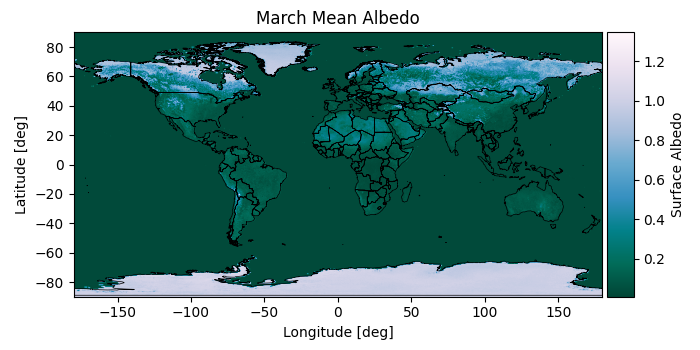
Plotting the solar zenith angle
mrv.plot_map_with_grid(
solar_zenith_grid,
f'Solar Zenith Angles: {datestr}',
'Solar zenith angle [rad]',
cmap='Blues',
borders=True,
)
plt.show()
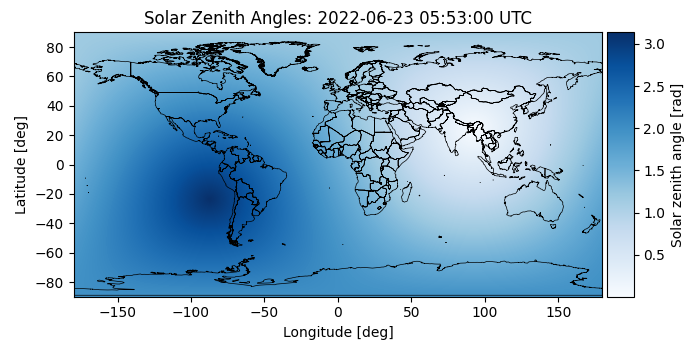
Plotting the twilight types
mrv.plot_map_with_grid(
solar_type_grid,
f'Twilight Types: {datestr}',
'',
cmap=mpl.colormaps['Blues'].resampled(5),
borders=True,
cbar_tick_labels=[
'Day',
'Civil twilight',
'Nautical twilight',
'Astronomical twilight',
'Night',
],
)
plt.show()
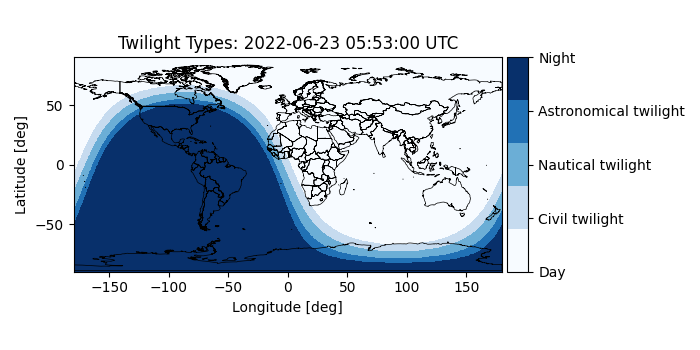
Plotting grid cell visibility and illumination conditions
mrv.plot_map_with_grid(
obs_type_grid,
f'Observation Conditions: {datestr}',
'Twilight Types',
cmap=mpl.colormaps['Paired'].resampled(4),
borders=True,
interpolation='nearest',
cbar_tick_labels=[
'Not visible or illum.',
'Visible not illum.',
'Illum. not visible',
'Illum. and visible',
],
)
plt.show()
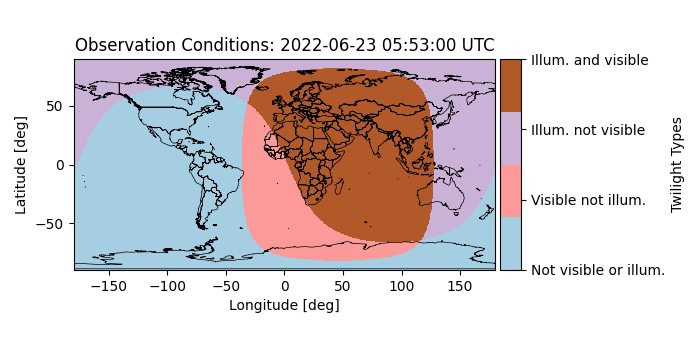
BRDF kernel values at each point
mrv.plot_map_with_grid(
loss_at_surf_diffuse + loss_at_surface_specular,
f'BRDF Kernel: {datestr}',
'',
cmap='Blues',
borders=True,
interpolation='nearest',
)
plt.show()
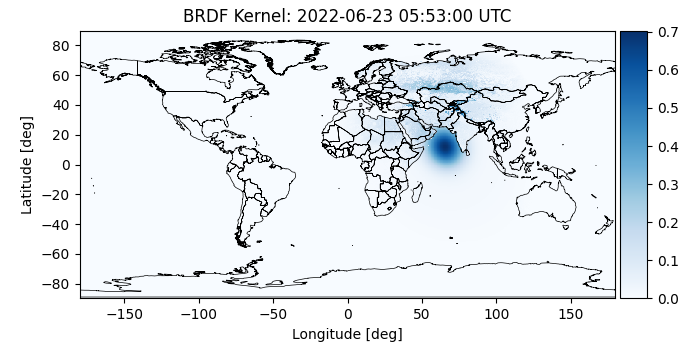
Plotting the areas of each grid cell
mrv.plot_map_with_grid(
cell_area_grid,
f'Cell Areas: {datestr}',
'$[m^2]$',
cmap='Blues',
borders=True,
interpolation='nearest',
)
plt.show()

Plotting the irradiance from each grid cell
mrv.plot_map_with_grid(
irrad_from_surf,
f'Reflected Irradiance: {datestr}',
r'$\left[W/m^2\right]$',
cmap='hot',
borders=True,
border_color='gray',
interpolation='nearest',
)
plt.show()
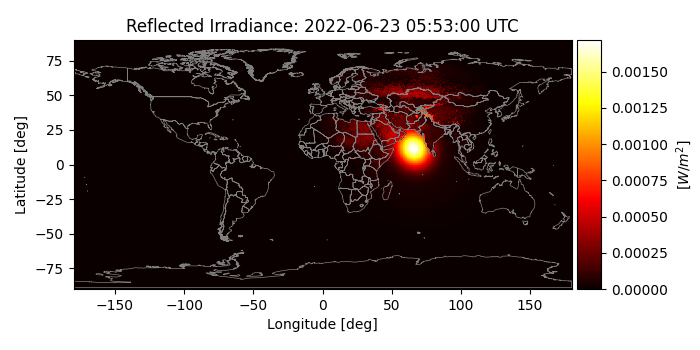
Total running time of the script: (0 minutes 3.907 seconds)
